Facebook local awareness ads are one of the best ways for small businesses to quickly and easily reach customers in their area. And, if you’re running ads for other people, local awareness ads are the best place to start.
This article is jam-packed with information on Facebook local awareness ads, including:
- What local awareness ads are
- The advantages of using them for your business
- What you should include in your local awareness ads
- Geo-targeting your ads
- Understanding and using call-to-action buttons
- The three most important metrics to look at
What are local awareness ads on Facebook?
Local business ads have the unique advantage of having a very limited population to work with, which makes targeting way easier. It’s more simple to target localized demographics, in part because the response to that targeting is much more obvious than it would be on a global scale.
In addition, small businesses rock, and we want to see more ads for the little guys down the street (sorry not sorry, Walmart). Those big companies have massive marketing departments that can dump money into ads. They can do market research, hire designers, etc.
That’s who local businesses are up against, and running local awareness ads is an inexpensive (more on this in a second) way for little guys to reach customers. Small business owners know that reaching people about local events and happenings has always been a struggle, but Facebook local awareness ads make it a little easier.
But, the best part of local ads?
Local awareness ads tell the story of a business.
You get the opportunity to help business tell that story. Here are some of the best ways to be successful with that:
- Use smiling faces in photos (specifically smiling faces that used the business you’re running ads for).
- Write compelling copy
- Talk to people in the area
Remember, you are vying for attention. A good story will grab someone’s attention, and it leads them to the local business you are trying to sell them. A little further down you can see exactly what to include in your ads.
Sometimes it helps to think about it like you’re talking to a friend. You wouldn’t start with “look at this amazing product, buy it.” No. You’d start with a story that engaged them, spoke to their interests, and then mention the product.
There is so much to know about running local ads…
In our Facebook Side Hustle Course, we teach people how to run Facebook ads for local businesses. It’s a comprehensive course that teaches you how to work this side hustle that can earn you $1,000-$1,500/month per client. In the Facebook Side Hustle Course, you’ll learn:
- How to set up a Facebook ad system for a local business
- How to find clients who want to pay you for this kind of service
- Exactly what you need to get these potential clients to say “yes” and agree to move forward
This course teaches you how to run a good ad strategy that sees real results, and it’s also great for small business owners who want to learn how to run their own ads effectively.
The advantages of using local awareness ads on Facebook
Facebook local awareness ads are super powerful, and you might not realize just how impactful they are.
1. They’re often cheaper than other forms of ads
PPC ads – like Google – and even traditional print, radio, and television ads cost a ton. And while we can’t say that a big-budget won’t help your Facebook ads do good things, even a few dollars a day can really make a difference. In fact, there’s a whole strategy built around “dollar-a-day” Facebook advertising.
In addition, using these services has become fairly easy, making geo-located ads a cinch. Usually, a bit of training for someone on your team can mean that you never have to hire a geofencing firm again (at least not for Facebook ads, and maybe not anything else either).
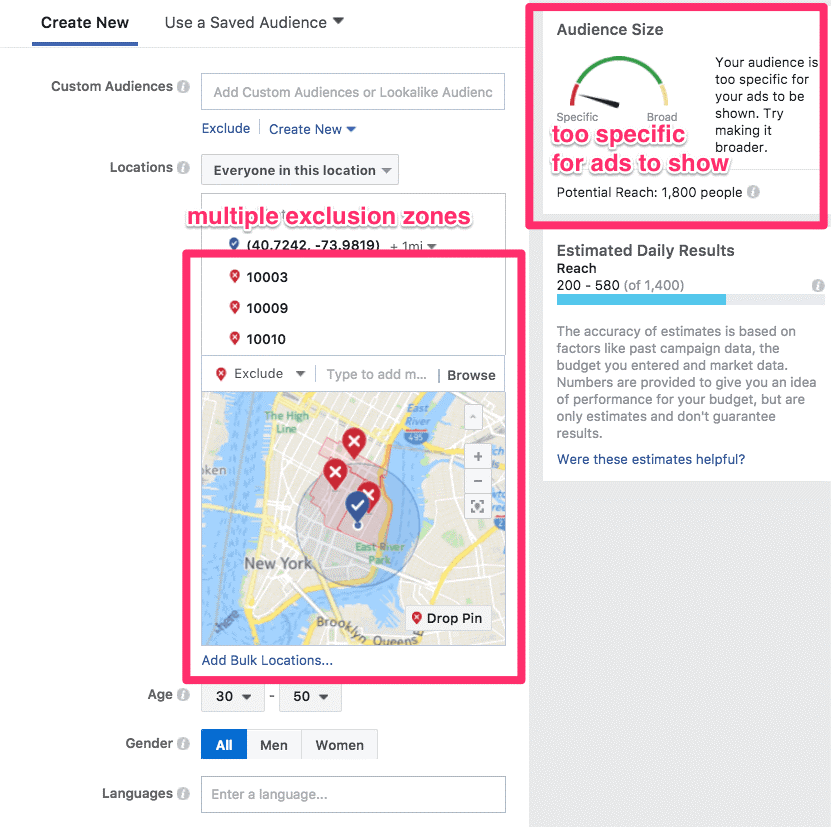
An example of what geographical exclusion and inclusion (geo-targeting) do to an ad, borrowed with love and permission from AdEspresso.
2. You’re inviting your local audience to come on over
In a world of digital advertising and paying for services for things you’ll never hold in your hands, this is something you should pay attention to, especially if you’re a small business looking for a strong following.
Do you have a happy hour on Tuesdays? Advertise it. Do you have a speakeasy word that entitles the speaker of that word to a special drink? Advertise it. Do you sell special potions that will make anyone fall in love with you, but they’re too delicate to ship? You got it: advertise it.
Brick-and-mortar businesses have to work to get their name out there. But, considering that the majority of the population your ad will reach is going to be people in your area, part of the work kind of gets done for you. This can be super effective for many businesses using Facebook local awareness ads.
In fact, there are instances when businesses just threw up an ad that invited folks to come on by to their corner store – and the results were astoundingly positive.
With local ads, you are in such a unique position in that you’re advertising online to customers who can literally drive to your location. Use this power.
While there are lots of ways to invite your target audience to your door, this is certainly a no-nonsense approach. It’s better than hiring someone to wear a Gumby suit and wave a sign around, right?
Unless you’re into that kind of thing.
3. Local awareness ads on Facebook are good for announcements
Are you doing a grand opening, a special sale, or a moving announcement? Facebook lets you run quick and easy ads for this kind of thing. Now, you’ll still want to stick a sign in the window if you moved across town or bring out the balloons if you’re having an awesome sale.
For these kinds of announcements, you can use local awareness ads to target very specific demographics in specific areas, keeping your advertising costs low, low, low.
What should your Facebook local awareness ads include?
For these ads to be as effective as possible at reaching customers and saving you money on advertising costs, you need to make sure you have the right components. While there’s not a one-size-fits-all answer, here are some of the best practices to use as a launching point. You’ll still need to test your ads, but with these tips, you’re not testing from the ground up.
Your photo should be on point
It’s hard to know what “on point” means to be honest; every audience will respond differently to different images, and you’ll probably have to do some testing in this department. Don’t be afraid to try a couple of different images, and keep in mind that sometimes… most of the time, sigh…. your favorite doesn’t make the cut.
Regardless of WHAT your image contains, here are a few quick pointers on the QUALITY of your image:
- Honesty. Stock images just do not cut it these days. Use images that you took, of your store, of your people, of your employees. An honest picture of a customer touching one of your products is way better than a random chick touching something that COULD be your product. If they can recognize parts of your store (what happens when you use real images) they will feel included in your advertising. Yeah, we’ve been there! I know that place! Not like this chick.

Why yes, we DID pay for this photo just so we could include it here, thanks for asking
- Quality. Even if you love a picture, if it doesn’t have the sharpness and intrigue, don’t use it. You need to use images that make sense for your business but are also thought-out, to a point at least. Smiling faces should not be blurry. Don’t use images that will pixelate in a Facebook ad. Keep them G-rated. That sort of thing. Check out this cute kid eating ice cream, for example. There are folks in the background, ice cream is messy, etc but the image is still sharp (and pretty cute).
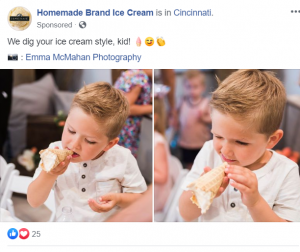
- Relevant. Your images should make sense for the audience you are targeting. Remember, confused people don’t buy, they don’t click, and sometimes they actually comment their confusion. Then they move on.
Compelling copy
Just like your photo needs to be direct in its content and sharp in its look, your copy needs to do the same thing. Using simple language, your copy should be short and lead with value.
You want to be direct in telling your audience about your service/product, meaning they need to know:
- What you’re offering
- How it benefits them
- What to do next
The photo you use in your ads will likely grab their attention, and your copy is what should hold them there long enough to click on your ad.
You should have a local perspective
If you’re running ads for your business, then you know your customers and area. But, if you’re running ads for a client, then you better darn well know a little something about said client, very importantly their place in the community.
One of the best ways to learn this is to talk to people in the area to see what it is they know and love about this business. You don’t need a full-on survey, but pop in the shop next door and ask if the tamales at the Mexican restaurant your running ads for are really as good as they say.
You can look up the business to see if they’ve won any awards, featured in magazines, do any community outreach, etc. All of this information helps you create a better and more nuanced ad that will engage the local audience.
When in doubt, test
If you’re not sure which picture of a kid eating ice cream is the right one, run a test. If you’re stuck between two versions of copy that have just the most subtle difference, run a test. Keep a constant in there, like the same copy and two different photos, or the other way around. Then see which one gets the most likes, comments, and conversions.
It takes a little time and money, but trust us, it’s worth it in the long run. That’s true whether you’re running Facebook local awareness ads for other businesses or doing it for yourself.
You’ll grow your knowledge base on what does and doesn’t work for a specific business, specific market, etc.
Should I be doing geo-targeted local awareness ads on Facebook?
Probably.
However, the strength in Facebook local awareness ads is going to come in from specifically brick-and-mortar stores. While you can absolutely run ads for services that do not have a specific location (or services that come to you), stores with physical locations are going to benefit tremendously off of local targeting.
When done correctly and with a bit of tweaking, local ads will get bodies in stores. This isn’t something that every advertising service can do, especially with a one-shot ad.
If your store sells something that could be considered “generic,” service-wise or product-wise, creating a localized following around it can be exceedingly useful. If you live in Ohio, do you have scents of your candle that you sell that are named after places in Ohio? The Cleveland Rocks candle should be a staple, or the Buckeye-scented oils that go in those cool diffusers you plugin and smell for weeks after you turn them off. If you can work up a local pride in it, run an ad for it.
In addition, ask yourself these questions! Don’t let them paralyze you, but see if they can help you focus even more.
Where’s your store?
The location of your store is going to matter. Are you downtown, or are you in a more rural area? You can do ads either way, but sometimes they might be less effective if you use zip codes for targeting if you’re more remote, for example.
Are you selling products or services?
The autonomy of an ad built for a chiropractor and one built for carpet cleaning are going to look and feel much different.
What if you want to geo-target but don’t have a local location?
Good question – and one we can’t give you an exact answer on. However, general knowledge and industry standards do indicate that you will benefit from some local targeting even if you do business anywhere.
You can target the Midwest, for example, especially if your ad is targeting something that has to do with the Midwest – like corn. People in the Midwest are going to relate way more to a funny corn ad than Californians (sorry you miss out on the joke California).

The call-to-action buttons of local awareness ads
Facebook local awareness ads have a paired-down selection of call-to-action buttons, which isn’t a bad thing. It means that it’s way easier to test which one is most effective, which saves some cash on your end.
A call-to-action button pops up on each and every ad, but you can opt-out of it if you don’t think it’ll be effective (hint: don’t do that). Here is where the button will always pop up:
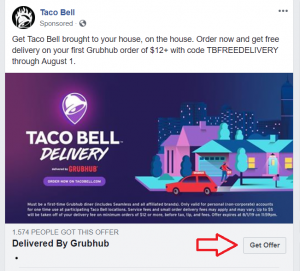
And, straight from Facebook’s knowledge base, here are the options you’re going to have:
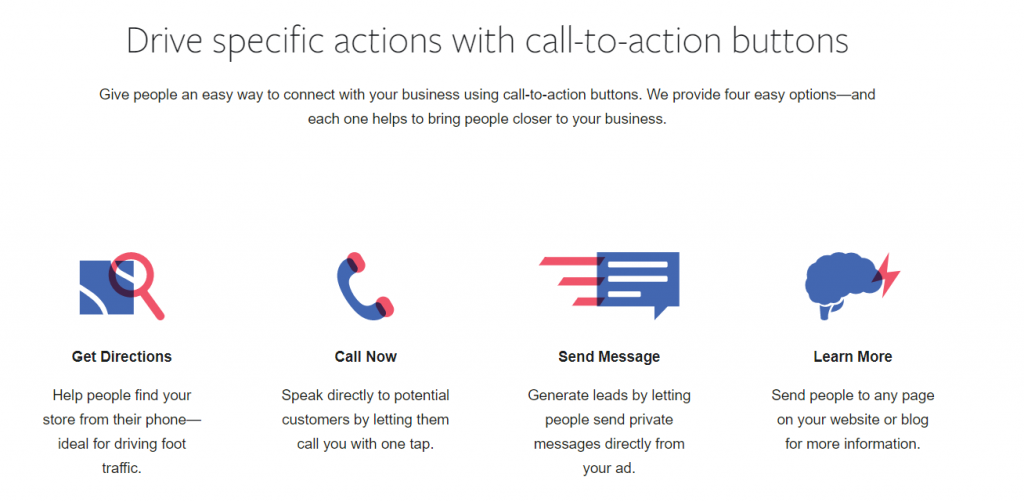
Get directions
When this button is tapped, the ad delivers basic location and directions to the tapper’s phone. This is great for use for ads that require people to walk in.
Call now
Do you think people will have questions, or do they need to book over the phone? Use the call now CTA.
Send message
This is often paired with messenger bots that are becoming more and more popular as time goes on, but they aren’t perfect yet, so make sure you either a) have it set up really, really well or b) are around to answer messages as fast as you can.
Learn more
Simple and straightforward. These buttons can take a person to a blog or website, but most often are linked to an ad-unique landing page that requires sign-up for a particular deal or download. With Facebook local awareness ads, this could be something fun like a coupon for 50% off an appetizer or a free drink.
The three most important metrics to look at when running Facebook local awareness ads
Ads give you a lot of data and depending on the campaign, you’ll want to look at different metrics. However, if you’re not too sure where to start, we suggest you look at…
- Reach and frequency. You want to know how many people have seen your ad and how often. These two metrics combined will show you that. PS – if your ad stops performing well, this is a great place to look. Your frequency could be getting too high and often does with smaller audiences.
- CPM (cost per 1,000 impressions). Are you reaching as many people as you’d like to reach? Since Facebook usually auto-bids in the ad-space auction house for you, this cost can and will vary depending on how people react to your ad and how often they mark it as spam. There are no good or bad metrics here. The only good or bad things when it comes to CPM is how your LAST ad performed. Did it do worse or better than your current ad?
- Lots of people put lots of stock into this, and it IS important, so you should be looking at this metric on your campaign. However, what’s going to really matter is the QUALITY of the clicks you get, which can be more accurately measured by looking at who is signing up for your coupon or who actually comes to your event.
Remember, the geo-targeting aspect of ads is only one tool you can use in your tool belt. There are countless ways you can improve and change ads with or without local awareness targeting, and understanding those tools will make your life a LOT better when it comes to running ads and saving cash from mistakes.
A final word on running Facebook local awareness ads
Local awareness ads have their place and are essential for small businesses, especially with brick and mortar locations. And while they’re not for everyone, knowing how to run them for a business and having that knowledge in your wheelhouse isn’t a bad choice for a hustler.
You never know when someone’s going to come to you and need your assistance for their local paint & wine studio or chiropractic business. Why not be prepared with the knowledge you need to help?
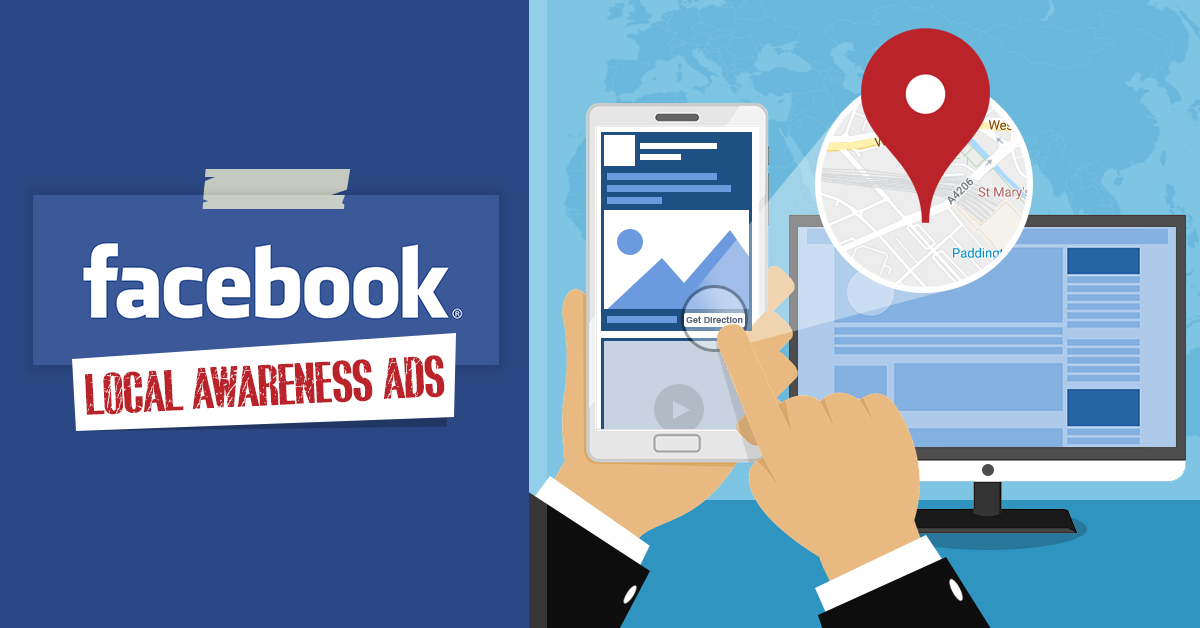

Leave a Reply